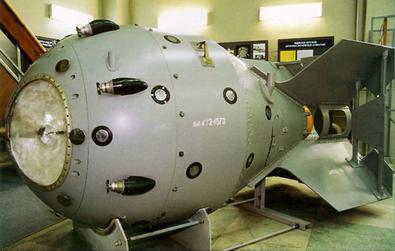RDS-1
The RDS-1 (Russian: РДС-1), also known as Izdeliye 501 (device 501) and First Lightning (Russian: Пе́рвая мо́лния, tr. Pyérvaya mólniya, IPA: [ˈpʲervəjə ˈmolnʲɪjə]),[1] was the nuclear bomb used in the Soviet Union's first nuclear weapon test. The United States assigned it the code-name Joe-1, in reference to Joseph Stalin. It was detonated on 29 August 1949 at 7:00 a.m.,[2] at the Semipalatinsk Test Site, Kazakh SSR,[3] after top-secret research and development as part of the Soviet atomic bomb project.
Response in the West[edit]
The test surprised the Western powers. American intelligence had estimated that the Soviets would not produce an atomic weapon until 1953, while the British did not expect it until 1954.[13] When the nuclear fission products from the test were detected by the U.S. Air Force, the United States began to follow the trail of the nuclear fallout debris.[14] President Harry S. Truman notified the world of the situation on 23 September 1949: "We have evidence that within recent weeks an atomic explosion occurred in the U.S.S.R."[15] Truman's statement likely in turn surprised the Soviets, who had hoped to keep the test a secret to avoid encouraging the Americans to increase their atomic programs, and did not know that the United States had built a test-detection system using the WB-29 Superfortress.[14] The announcement was a turning point in the Cold War, that had just begun. Once the Soviet Union was confirmed to be in possession of the atomic bomb, pressure mounted to develop the first hydrogen bomb.[15]
